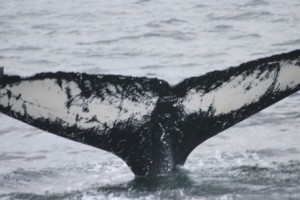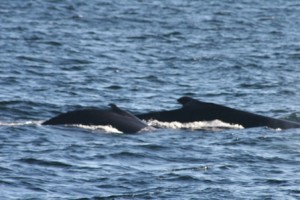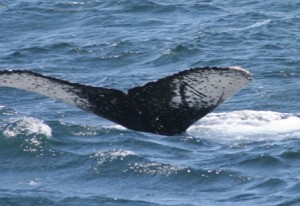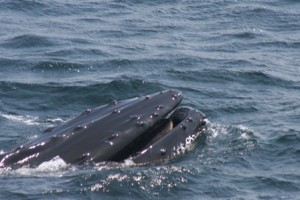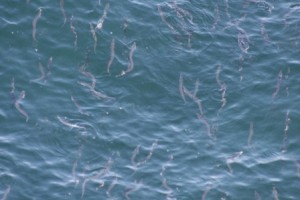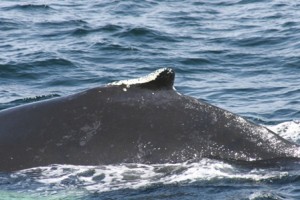Naturalist Notebook, 24 May to 30 May
Dolphin Fleet Naturalist Notebook, 24 May to 30 May
May 24th was a gray spring day, and the Dolphin VII left Provincetown harbor mid-day and headed for the Southwest Corner of Stellwagen Bank. This area, just a few miles northwest of Provincetown, is often a good place to find whales as well as other wildlife. The steep wall of the bank is an obstacle to cold, nutrient-rich currents. As they hit the vertical edge of the wall, the currents sweep up organic debris from the base of the bank, bringing nutrients to the surface, and setting off a chain reaction of productivity in the complex food web. The nutrients nourish the phytoplankton, which in turn, nourishes the zooplankton, feeding the small schooling fish upon which the humpback whales feast. Today, one humpback whale, Fulcrum, was taking advantage of the rich food resources in the area.
Mural
Our second whale watch of the day took us to two different humpback mother and calf pairs. Shockwave, a mature female seemed to rest. Her calf, however, seemed to have more energy, and was seen lobtailing and tail breaching. Meanwhile, Mural, another 2008 humpback mom, stood by as her calf rolled around playfully at the surface. Mural was first seen in 1980 and this is her second known calf.
On May 25, we returned to the same area to find many of the same individuals, engaged in very different behaviors. Mural and Shockwave, humpback mothers seen on the previous day, were spending their morning foraging and eating. Being a humpback whale mother requires a huge amount of energy, so this is no surprise! When a humpback whale calf is born, it ways about a ton and is between 10 and 12 feet in length. In the photo below, compare the size of the small calf and its 45 foot long mother!
Spoon and calf
When a mother humpback gives birth to her calf, she is not only fasting, due to the lack of food resources in the calving grounds, but she is also producing a highly caloric milk for her calf. During the process of giving birth and nursing, a humpback whale might lose up to one third of her body weight! She will need to eat up to one ton of food per day once she returns to the feeding ground to restore her blubber layer.
May 26th was bright and sunny and we decided to check out another area, east of Stellwagen Bank, which is often a hot spot for whales. Sure enough, we were able to locate another humpback mother, Sloop, and and her calf that we hadn’t seen that week. Sloop is now a mother three times over. She is 21 years old.
Sloop
Midway through the trip, the wind started to pick up noticably, at which point, Sloop’s calf began to breach. For some reason, winds sometimes inspire this acrobatic behavior in whales. No one knows exactly why whales breach, or jump out of the water, but perhaps in this case it is some sort of response to rough sea conditions.
Although only one trip went out on May 27th, our naturalist documented three more humpback mother and calf pairs. So far this season, 25 mother and calf pairs have been documented throughout the Gulf of Maine. Last year’s Gulf of Maine humpback calf count totaled 70! It is going to be exciting to see which of these calves return this season. When a calf returns to the feeding ground without its mother in its second year of life, it receives a name. By photographing and identifying whales as individuals, researchers can glean a lot of demographic information, including population size. Estimating population size is crucial in determining a conservation management plan for endagered species such as the humpback!
On May 28th, among the excitement of dozens of feeding humpbacks, including Rune, Rapier, and Ganesh, our naturalist was also excited to note the arrival of a number of sooty shearwaters. The arrival of these birds truly marks the beginning of summer. Like the whales, these birds have completed an incredibly long migration–one of the longest in the avian community–in order to feed on the rich food resources of Stellwagen Bank and the surrounding waters. As the humpbacks blew clouds of bubbles to trap schools of fish, these birds flew low over the water in order to snatch up any morsels that the whales missed!
Feeding humpback whales are some of the most exciting sights to see out on Stellwagen Bank. On May 29th, we were lucky enough to witness this behavior on one of our afternoon trips. Filament, a female humpback born in 1989, used her powerful tail to slap the surface of the water to stun and corral sand lance so she could scoop them up and trap them in her bristly baleen. Sand lance, otherwise known as sand eels, are small schooling fish, which can reach lengths of up to 6 inches. They spawn during the early winter months, with each female producing up to 23,000 eggs! Thsi may seem like a lot, but the sand eel is an important food source for not only the humpbacks, but also other members of the ecosystem, such as birds and larger fish.
A school of sand lance
May 30th was a significant day for the Dolphin Fleet, as it was one of the first trips of the season where our favorite humpback, Salt, was seen. In the mid 1970s, the late Aaron Avellar, then a captain on the Dolphin Fleet, began the tradition of naming Gulf of Maine humpbacks by noticing that one whale looked as though someone had sprinkled salt all over her dorsal fin. Salt has returned to Stellwagen Bank ever since then. This is a particularly special year, as Salt has returned with her 11th known calf. The Avellar family is now priveleged to name every one of Salt’s offspring, and Chad Avellar, Aaron’s son, has named this one Sanchal. Chad offers the following explanation: “Sanchal is a black salt which is mined in the mountains of India and Pakistan, its flavor is more sulfurous and is not used as table salt.”






